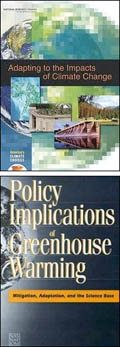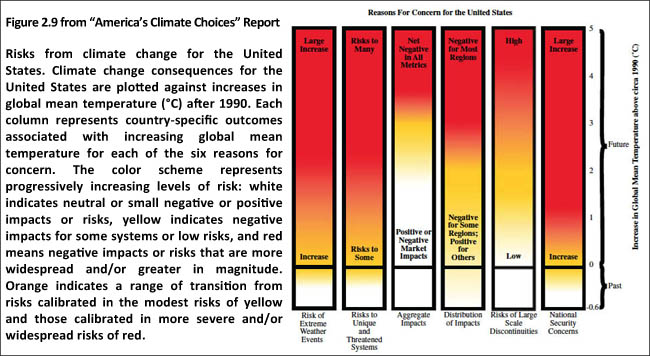Ogmius exchangeIntroduction to Ogmius ExchangeThis issue of Ogmius features an article by Center for Science and Technology Policy Research director William (Bill) Travis comparing recommendations for adaptation to climate change in the U.S. from two National Academy of Science reports issued almost two decades apart: “America’s Climate Choices”, and “Policy Implications of Greenhouse Warming”. Bill is an Associate Professor of Geography at the University of Colorado, Boulder. His teaching and research focus on human behavior in the environment, including studies of the human dimensions of climate change, land use and the interaction of people and ecosystems. His current projects focus on the theme of potential social response to extreme climate change, including warning systems, the most transformative and difficult adaptive choices, and geo-engineering responses in the face of a “climate emergency.” Comments welcome! info@sciencepolicy.colorado.edu |
 |
Two Decades and Two Adaptation Panels: What Progress?
|
 |
Both panels operated under the assumption that anthropogenic global warming would significantly alter the climate and noticeably affect social and ecological systems in coming decades. Both panels took their cues on the physical nature of climate change from associated climate science panels. The COSEPUP study did not focus as much attention on whether global warming was underway or not, settling instead on a wide range of warming (1 to 5 degrees C) likely to eventuate from a doubling of GHG concentrations, which they expected in the middle of the 21st century. ACC’s climate change conclusions were, as might be expected, more definitive: “Climate change is occurring, is caused largely by human activities, and poses significant risks for a broad range of human and natural systems." (p. 1). ACC’s posture reflects the study’s main title: we need to inform and enlarge the range of choices available in the face of this problem, and its adaptation panel report is dominated by extensive rosters of potential responses, ranging from changes in crop varieties to land use. Still, in many ways these lists are not much different from the options embedded in the COSEPUP narrative, both stressing relatively low-regrets options linked to other benefits, such as water conservation, habitat protection, and strengthened building codes. COSEPUP paid more attention to the economics of adaptation, using cost as one measure of feasibility, while ACC focused more on the strategy of adaptation, stressing public sector planning and policy reforms that could aid it. One marked difference over the two decades separating the reports is that the ACC panel was able to cite “early adaptation activities” (Table 3.1, pp. 63-64) among several U.S. locales. Most of those listed are plans for future adaptation, but they are, nevertheless, explicit adaptations to climate change not extant at the time of the COSEPUP study. COSEPUP drew more heavily on past and then-current responses to weather and climate extremes to tease out specific adaptive actions and policies (e.g., use of the Dust Bowl droughts as an analog to future climate change, pp. 625 and 628), and both panels argued that better management of current extremes would aid future adaptation. Overall, both panels take a pragmatic approach to adaptation, wrestling less with the potential failure of adaptation and more with how to get it done, within, say, typical capital and infrastructure replacement cycles (COSEPUP) and common public sector planning rubrics like urban growth and water supply plans (ACC). COSEPUP is perhaps a bit more optimistic about adaptation, concluding that: "So far as we can reason from assumed gradual changes in climate, their impacts will be no more severe, and adapting to them will be no more difficult, than for the range of climates already on earth and no more difficult than for other changes humanity faces" (p. 657). Similar sanguine conclusions for agriculture, industry, infrastructure and ecosystems led one panel member to write a dissent to the report’s “complacent tone” and conclude: “In summary I disagree with the report’s implicit message, that ‘we can adapt with little or no problem’” (p. 659). ACC attends more to institutional barriers to adaptation (pp. 121-124), yet, like COSEPUP, conveys a message that we can adapt: “At moderate rates and levels of climate change, adaptation can be very effective” (p. 30), while cautioning that effective adaptation requires us to formulate a “well-integrated, comprehensive planning process and an adaptive risk-management approach” (p. 156). The panel offers a blueprint for such a planning system, covering all sectors and all levels of government (see especially Chapter 5). Both panels at least hint at a limit on adaptability. ACC’s adaptation panel, after offering dozens of practical adaptation suggestions, cautioned that continuing climate change could eventually surpass even the adaptive capacity of a relatively rich, developed nation. “At severe rates and levels of climate change, limits of many adaptation options are likely to be reached, and resulting adaptations are likely to be much more disruptive” (ACC, pp. 330-31). But where such limits might appear remained unspecified. The panel, using the ultimate adaptation to sea level rise as an exemplar, suggested where experience and knowledge fail us:
Ultimately, both panels only nibble at the edges of the potential for severe climate change, mal-adaptation, and failed adaptation. In a brief mention of potentially abrupt, severe change, COSEPUP concluded that “The probability and nature of such unexpected changes are unknown. Therefore we cannot predict their impacts or devise adaptations to them” (p. 507). The ACC panel touched on the possibility that we will find ourselves trying to adapt to severe rates and levels of climate change, and included “risks of large scale discontinuities” in its U.S.-focused version of the IPCC’s “reasons for concern” diagram (p. 51). |
|
 |
Yet ACC’s adaptation panel likewise hardly touched on the upper range of potential climate change illustrated in that graphic, and included few adaptations that might be termed transformative (e.g., reform proposals for the National Flood Insurance Program, box 4.8) among its lengthy action rosters for various sectors. They conclude with a truism: “If the magnitude of climate change is relatively severe, as depicted in the USGCRP higher projection, then regions, sectors, and systems will be hard-pressed to cope with impacts and their costs” (p. 60, emphasis added). What is most striking about both adaptation panel reports, then, is their lack of dramatic language compared to much of what we read about global warming, and their almost work-a-day approach to adaptation: the same tools we use to cope with current weather and climate variability, properly honed and structured into a progressive planning strategy, can help us adapt to climate change. We will see ... William Travis |

